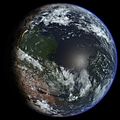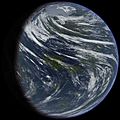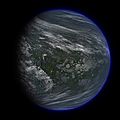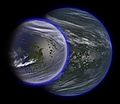Terraforming facts for kids
Terraforming is a big idea about changing a planet or moon to make it more like Earth. The goal is to make it a place where humans and Earth life could live and grow. This would mean giving it the right kind of air (an atmosphere), enough warmth, and water.
Some scientists and thinkers believe it might be possible to terraform places like Mars, our own Moon, Titan (a moon of Saturn), Callisto (a moon of Jupiter), and even Mercury.
You could even say that humans have already done a bit of terraforming right here on Earth! Thanks to amazing technology, people can now live and thrive in places that used to be impossible, like hot deserts and the freezing Arctic.
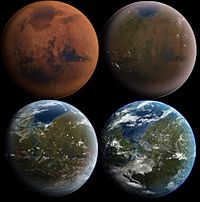
Contents
What is Terraforming?
Terraforming means "Earth-shaping." It's the idea of taking a planet or moon that is currently too cold, too hot, or has no breathable air, and changing it. The aim is to make it suitable for humans to live there without special suits or domes. Imagine turning a barren rock into a place with blue skies, oceans, and green plants!
Why Terraform Other Worlds?
People think about terraforming for a few reasons. One big reason is to find new places for humans to live as our population grows. Another is to access resources that might be on other planets. It's also about the exciting challenge of exploring and expanding humanity's reach into space.
How Could We Terraform a Planet?
Terraforming is a huge and very difficult task. Scientists have many ideas, but they are mostly theories right now.
Terraforming Mars
Mars is often seen as the best candidate for terraforming. It has water ice and a thin atmosphere.
- Warming Mars: One idea is to release gases that trap heat (greenhouse gases) into Mars's atmosphere. This would warm the planet, melting the ice and releasing more water.
- Creating an Atmosphere: As Mars warms, frozen carbon dioxide would turn into gas, making the atmosphere thicker. Plants could then be introduced to produce oxygen.
Terraforming Venus
Venus is very hot and has a thick, toxic atmosphere.
- Cooling Venus: One idea is to use giant sunshades in space to block some of the sun's light, cooling the planet.
- Removing Carbon Dioxide: Another challenge is getting rid of the massive amount of carbon dioxide in its atmosphere. This could involve complex chemical processes or even introducing special organisms.
Terraforming Moons and Mercury
- The Moon: Our Moon has no atmosphere and extreme temperatures. Terraforming it would be incredibly hard, possibly involving creating enclosed habitats first.
- Titan: Titan, Saturn's largest moon, has a thick atmosphere and liquid methane lakes. It's very cold, but its existing atmosphere makes it interesting.
- Callisto: Callisto, a moon of Jupiter, is icy. It would need significant warming and an atmosphere created from scratch.
- Mercury: Mercury is very close to the Sun, making it extremely hot on one side and freezing on the other. Terraforming it would be a massive challenge due to its lack of atmosphere and extreme temperatures.
Challenges of Terraforming
Terraforming is not just difficult; it's incredibly complex.
- Time: It would take thousands of years, maybe even millions, to terraform a planet.
- Technology: We don't have the technology yet to do most of these things on a large scale.
- Resources: It would require a huge amount of resources, energy, and money.
- Ethics: Some people also wonder if it's right to change other planets, especially if they might have their own forms of life.
Earth: An Example of Natural Terraforming?
Over billions of years, life on Earth has changed our planet's atmosphere and environment. For example, early bacteria produced oxygen, which completely changed Earth's air. In a way, life itself terraformed Earth into what it is today. Humans have also changed Earth's surface a lot, building cities, farms, and changing landscapes. This shows how living things can have a huge impact on a planet.
Images for kids
-
Artist's conception of a terraformed Venus
See also
 In Spanish: Terraformación para niños
In Spanish: Terraformación para niños


